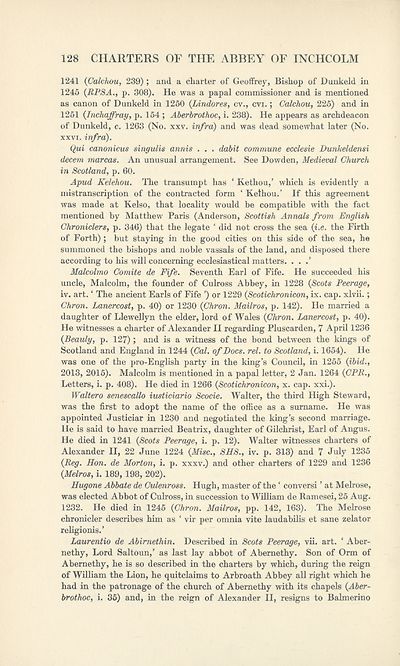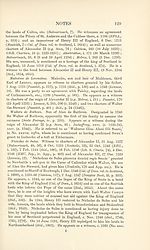Series 3 > Charters of the Abbey of Inchcolm
(181) Page 128
Download files
Complete book:
Individual page:
Thumbnail gallery: Grid view | List view

128 CHARTERS OF THE ABBEY OF INCHCOLM
1241 (Calchou, 239) ; and a charter of Geoffrey, Bishop of Dunkeld in
1245 (RPSA., p. 308). He was a papal commissioner and is mentioned
as canon of Dunkeld in 1250 (Lindores, cv., cvi.; Calchou, 225) and in
1251 (Inchaffray, p. 154 ; Aberbrothoc, i. 238). He appears as archdeacon
of Dunkeld, c. 1263 (No. xxv. infra) and was dead somewhat later (No.
xxvi. infra).
Qui canonicus singulis annis . . . dabit commune ecclesie Dunkeldensi
decern marcas. An unusual arrangement. See Dowden, Medieval Church
in Scotland, p. 60.
Apud Kelehou. The transumpt has ‘ Kethou,’ which is evidently a
mistranscription of the contracted form ‘ Kethou.’ If this agreement
was made at Kelso, that locality would be compatible with the fact
mentioned by Matthew Paris (Anderson, Scottish Annals from English
Chroniclers, p. 346) that the legate ‘ did not cross the sea (i.e. the Firth
of Forth); but staying in the good cities on this side of the sea, he
summoned the bishops and noble vassals of the land, and disposed there
according to his will concerning ecclesiastical matters. . . .’
Malcolmo Comite de Fife. Seventh Earl of Fife. He succeeded his
uncle, Malcolm, the founder of Culross Abbey, in 1228 {Scots Peerage,
iv. art. ‘ The ancient Earls of Fife ’) or 1229 {Scotichronicon, ix. cap. xlvii.;
Chron. Lanercost, p. 40) or 1230 {Chron. Mailros, p. 142). He married a
daughter of Llewellyn the elder, lord of Wales {Chron. Lanercost, p. 40).
He witnesses a charter of Alexander II regarding Pluscarden, 7 April 1236
{Beauly, p. 127); and is a witness of the bond between the kings of
Scotland and England in 1244 {Cal. of Docs. rel. to Scotland, i. 1654). He
was one of the pro-English party in the king’s Council, in 1255 {ibid.,
2013, 2015). Malcolm is mentioned in a papal letter, 2 Jan. 1264 {CPB.,
Letters, i. p. 408). He died in 1266 {Scotichronicon, x. cap. xxi.).
Waltero senescallo iusticiario Scocie. Walter, the third High Steward,
was the first to adopt the name of the office as a surname. He was
appointed Justiciar in 1230 and negotiated the king’s second marriage.
He is said to have married Beatrix, daughter of Gilchrist, Earl of Angus.
He died in 1241 {Scots Peerage, i. p. 12). Walter witnesses charters of
Alexander II, 22 June 1224 {Misc., SHS., iv. p. 313) and 7 July 1235
{Reg. Hon. de Morton, i. p. xxxv.) and other charters of 1229 and 1236
{Metros, i. 189, 198, 202).
Hugone Abbate de Culenross. Hugh, master of the ‘ conversi ’ at Melrose,
was elected Abbot of Culross, in succession to William de Ramesei, 25 Aug.
1232. He died in 1245 {Chron. Mailros, pp. 142, 163). The Melrose
chronicler describes him as ‘ vir per omnia vite laudabilis et sane zelator
religionis.’
Laurentio de Abirnethin. Described in Scots Peerage, vii. art. ‘ Aber-
nethy, Lord Saltoun,’ as last lay abbot of Abemethy. Son of Orm of
Abemethy, he is so described in the charters by which, during the reign
of William the Lion, he quitclaims to Arbroath Abbey all right which he
had in the patronage of the church of Abernethy with its chapels {Aber¬
brothoc, i. 35) and, in the reign of Alexander II, resigns to Balmerino
1241 (Calchou, 239) ; and a charter of Geoffrey, Bishop of Dunkeld in
1245 (RPSA., p. 308). He was a papal commissioner and is mentioned
as canon of Dunkeld in 1250 (Lindores, cv., cvi.; Calchou, 225) and in
1251 (Inchaffray, p. 154 ; Aberbrothoc, i. 238). He appears as archdeacon
of Dunkeld, c. 1263 (No. xxv. infra) and was dead somewhat later (No.
xxvi. infra).
Qui canonicus singulis annis . . . dabit commune ecclesie Dunkeldensi
decern marcas. An unusual arrangement. See Dowden, Medieval Church
in Scotland, p. 60.
Apud Kelehou. The transumpt has ‘ Kethou,’ which is evidently a
mistranscription of the contracted form ‘ Kethou.’ If this agreement
was made at Kelso, that locality would be compatible with the fact
mentioned by Matthew Paris (Anderson, Scottish Annals from English
Chroniclers, p. 346) that the legate ‘ did not cross the sea (i.e. the Firth
of Forth); but staying in the good cities on this side of the sea, he
summoned the bishops and noble vassals of the land, and disposed there
according to his will concerning ecclesiastical matters. . . .’
Malcolmo Comite de Fife. Seventh Earl of Fife. He succeeded his
uncle, Malcolm, the founder of Culross Abbey, in 1228 {Scots Peerage,
iv. art. ‘ The ancient Earls of Fife ’) or 1229 {Scotichronicon, ix. cap. xlvii.;
Chron. Lanercost, p. 40) or 1230 {Chron. Mailros, p. 142). He married a
daughter of Llewellyn the elder, lord of Wales {Chron. Lanercost, p. 40).
He witnesses a charter of Alexander II regarding Pluscarden, 7 April 1236
{Beauly, p. 127); and is a witness of the bond between the kings of
Scotland and England in 1244 {Cal. of Docs. rel. to Scotland, i. 1654). He
was one of the pro-English party in the king’s Council, in 1255 {ibid.,
2013, 2015). Malcolm is mentioned in a papal letter, 2 Jan. 1264 {CPB.,
Letters, i. p. 408). He died in 1266 {Scotichronicon, x. cap. xxi.).
Waltero senescallo iusticiario Scocie. Walter, the third High Steward,
was the first to adopt the name of the office as a surname. He was
appointed Justiciar in 1230 and negotiated the king’s second marriage.
He is said to have married Beatrix, daughter of Gilchrist, Earl of Angus.
He died in 1241 {Scots Peerage, i. p. 12). Walter witnesses charters of
Alexander II, 22 June 1224 {Misc., SHS., iv. p. 313) and 7 July 1235
{Reg. Hon. de Morton, i. p. xxxv.) and other charters of 1229 and 1236
{Metros, i. 189, 198, 202).
Hugone Abbate de Culenross. Hugh, master of the ‘ conversi ’ at Melrose,
was elected Abbot of Culross, in succession to William de Ramesei, 25 Aug.
1232. He died in 1245 {Chron. Mailros, pp. 142, 163). The Melrose
chronicler describes him as ‘ vir per omnia vite laudabilis et sane zelator
religionis.’
Laurentio de Abirnethin. Described in Scots Peerage, vii. art. ‘ Aber-
nethy, Lord Saltoun,’ as last lay abbot of Abemethy. Son of Orm of
Abemethy, he is so described in the charters by which, during the reign
of William the Lion, he quitclaims to Arbroath Abbey all right which he
had in the patronage of the church of Abernethy with its chapels {Aber¬
brothoc, i. 35) and, in the reign of Alexander II, resigns to Balmerino
Set display mode to:
![]() Universal Viewer |
Universal Viewer | ![]() Mirador |
Large image | Transcription
Mirador |
Large image | Transcription
Images and transcriptions on this page, including medium image downloads, may be used under the Creative Commons Attribution 4.0 International Licence unless otherwise stated. ![]()
| Scottish History Society volumes > Series 3 > Charters of the Abbey of Inchcolm > (181) Page 128 |
|---|
| Permanent URL | https://digital.nls.uk/128322947 |
|---|
| Attribution and copyright: |
|
|---|
| Description | Over 180 volumes, published by the Scottish History Society, containing original sources on Scotland's history and people. With a wide range of subjects, the books collectively cover all periods from the 12th to 20th centuries, and reflect changing trends in Scottish history. Sources are accompanied by scholarly interpretation, references and bibliographies. Volumes are usually published annually, and more digitised volumes will be added as they become available. |
|---|


